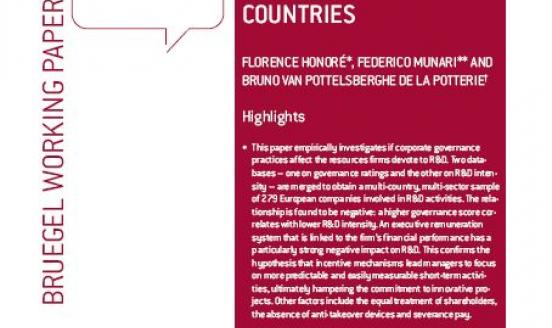A Long March to an EU Patent?
Senior Resident Fellow Bruno van Pottelsberghe discusses the next steps policymakers need to take after EU industry ministers agreed on a package on 4 December that may pave the way for a European community patent (COMPAT). Discussing the effects of such a patent, van Pottelsberghe points to his recent working paper on the costs and benefits of the COMPAT and argues that national decision-makers must act so as not to get leapfrogged by China and other developing economies.
Forty-seven years after the first call for a Community patent, the EU may have taken the first step.
The package agreed by EU industry ministers on 4 December may pave the way for an „EU' or community patent – but, if it does, it will at most be the first, symbolic step of what may well be a „long march' (“Push for harmonised EU patent regime”, 19-25 November).
What the ministers have agreed is to think of creating a centralised European patent litigation system and to ask the European Court of Justice to provide an assessment of the legal „feasibility' of creating a Central Appeal Court to hear related claims. (The latter says much about the European negotiation process: industry has been asking for a community patent for 47 years, and only now has an expert assessment been requested.)
This welcome step should not hide the important details that must still be resolved and on which little progress has been made, issues such as languages, fees and governance. The devil will be details such as these.
The package of legislation that has been agreed to would, at most, produce minor advances, since aspects critical to the establishment of an effective patent system in Europe have been overlooked.
I and Jérôme Danguy have, for Breugel, conducted a simulated cost-benefit analysis of the community patent, the results of which show that several hundred million euros that currently go to one or two types of institutions or lobby groups would move to other institutions and the business sector at large.
These simulations shed new light on the reasons why some lobbies have resisted a community patent, a project that would be a crucial to the development of hi-tech start-ups. The arguments that legal complexities and languages are major barriers to the creation of a truly European patent system are, in essence, fig leaves.
National decision-makers need to take their responsibilities seriously and shorten the „long march' to a European patent.
China, for example, is leapfrogging Europe in technological innovation: in 2008, its businesses spent more on research and development (more than 1% of gross domestic product) than Europe's did. In terms of patent applications, China overtook Europe in 2007 and, in 2008, 65% of the nearly 300,000 applications received by the Chinese patent office were from domestic assignees. In Europe, „local' firms accounted for about half of the 230,000 filings.
A weak entrepreneurial culture, a low research and development intensity, innovation leads lost to Japan, the US and China: what additional damage are we waiting for before we set up a
coherent and effective patent system in Europe, a system that would truly support our entrepreneurs and academic spin-offs?
Bruno van Pottelsberghe
Senior fellow, Bruegel
Professor, Université Libre de Bruxelles

